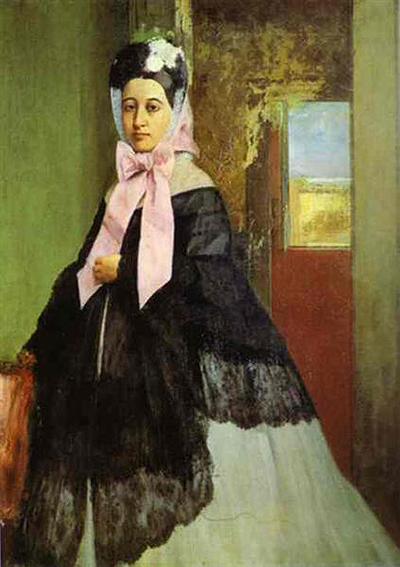The beautiful portrait of Therese Degas is that of Edgar Degas' sister. This portrait was painting in 1863, during the time when the artist created endless portraits of those around him. Some of the other pieces include Portrait Of James Tissot, and Madame Camus With A Fan.
The artist's sister will later change her name to Madame Edmond Morbilli, upon marriage. Other pieces where Degas included his sister are Portrait Of Madame Edmondo Morbilli Born Therese Degas, and Edmond and Therese Morbilli. Of portrait of the artist sister adds a similar tone to the work. It's fascinating to witness how much the artist's sister resembles him. In the painting, Self Portrait Saluting, we get a glimpse of the artist himself. These wide droopy eyes highly resemble his sisters, making a wonderful connection between the two. The young woman stands in an upright position to the side. While Degas is immensely known for using an off-centre perspective throughout his work, he prefers a centre perspective in his portraits. However, the artist commonly preferred to have his muses stand on the side during the painting of their portrait. This allowed the artist to focus on a more 3-D dimension rather than the muse in an upright position standing.
The beautiful woman stands to her right as she turns her face towards the viewer. She is dressed in a stunning snow white dress that falls towards the floor. Through the piece it's quite evident that the material of the dress is incredibly heavy with multiple layers underneath. Near the woman's shoulders a black fabric covers her body that falls into a black lace shawl. The detailing at the bottom of the shawl is absolutely stunning as the artist was gifted enough to showcase the see-through lace material. The viewer can see the glimpse of white coming through the lace. These characteristics are what Degas is most known for throughout his work as they show his impeccable eye for detail. While the carbon black shawl falls perfectly toward the floor, it seems as if the woman is holding it together in her left hand. The interesting design to note throughout her dress is the baby pink ribbon tied around the woman's neck. It seems to come from the fabric on her hat that ties at the front as a perfect ribbon. The viewer can also spot a glimpse of white chiffon fabric coming out of the womanÕs hat.
The background of the painting remains relatively plain in order to not any attention from the woman. Yet, nevertheless it is interesting to note that Degas decided to incorporate a neoclassic background to the work rather than in an Impressionism style. This is showcased as the detailing of the background is showcased much more clearly in what resembles a realist style. Rather than mixing paint colours and brush strokes together as one, Degas decided to add a tad more detailing through rough lines and distinctions. The green wall gently merges into small hints of gold throughout the piece. Near the background, the viewer can spot a small window that opens up towards the outside. It is interesting to note that this window illustrates a blue sky and yellow field that perfectly meet in the middle at the horizon. Degas was a masterful artist that even while showcasing his work from inside, he made sure to add endless detailing and a glimpse of the outside world.




